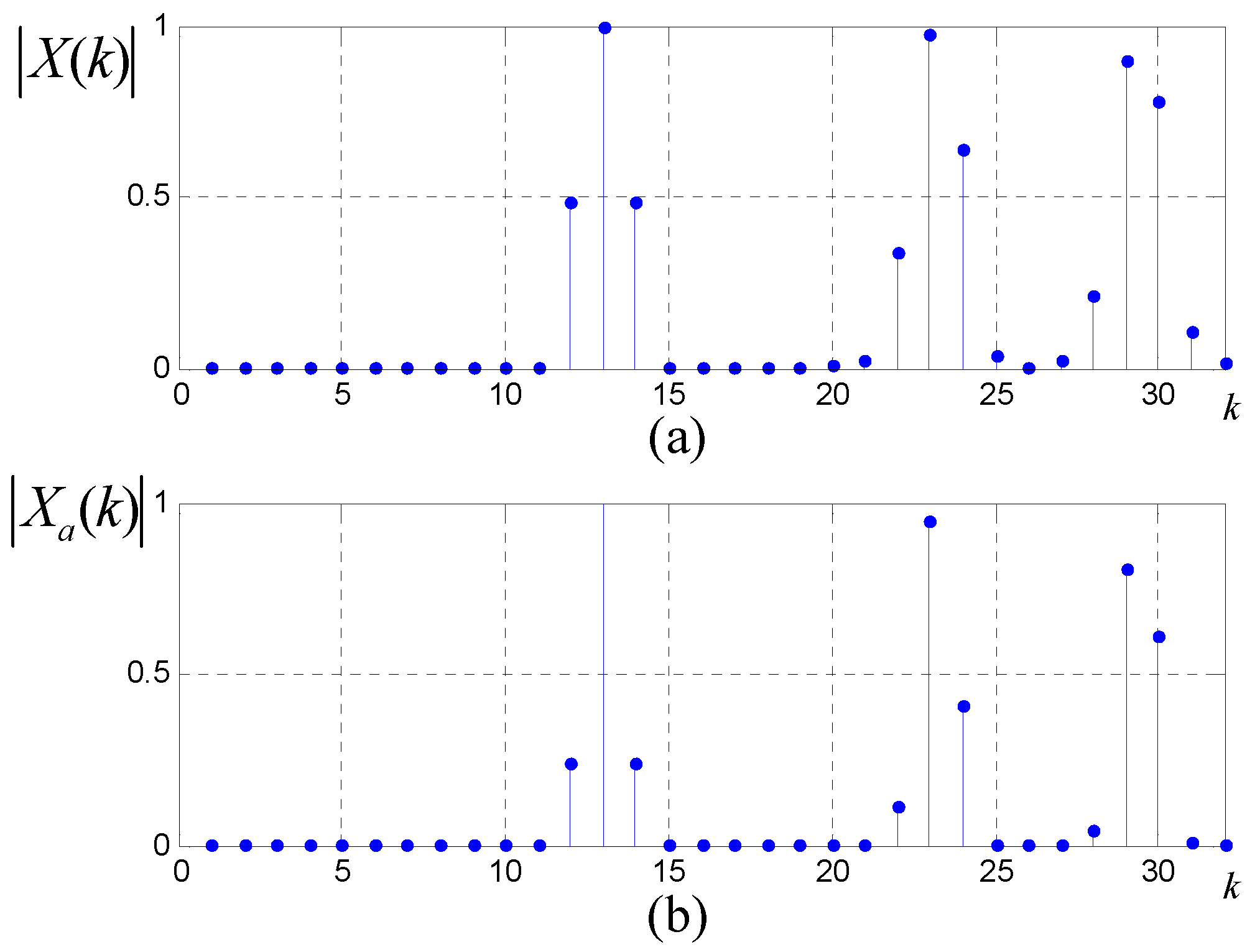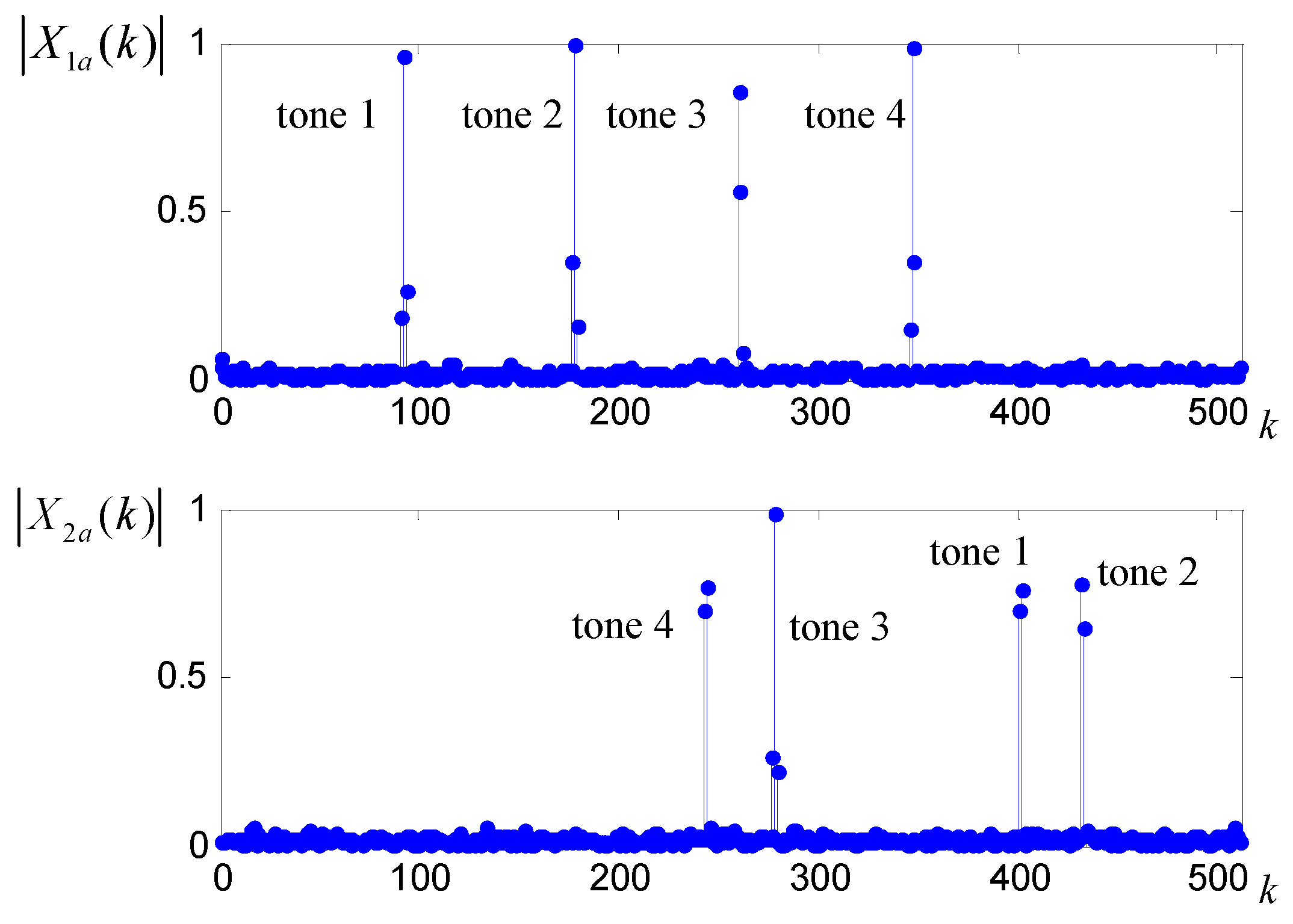Multi-Tone Frequency Estimation Based on the All-Phase Discrete Fourier Transform and Chinese Remainder Theorem
Abstract
:1. Introduction
2. Problem Formulation
2.1. CRT Reconstruction Model for the Single-Tone Case
2.2. CRT Reconstruction Model for the Multi-Tone Case
3. Proposed Method
3.1. All-Phase DFT Based Remainder Acquisition
3.2. Harmonic Parameter Clustering Based Remainder Classification
3.3. Determination Procedure of Multi-Tone Frequency Based on apDFT Analysis and CRT
| Algorithm 1: The optimized discrete spectral analysis (ODSA). |
|
4. Simulation Results and Discussion
4.1. Procedure Demonstration
4.2. Performance Analysis on the All-Phase DFT and Traditional DFT
4.3. Performance Analysis on Different Number of Data Acquisition Path
4.4. Analysis of Computation Complexity
5. Conclusions
Author Contributions
Funding
Conflicts of Interest
References
- Belega, D.; Petri, D. Frequency estimation by two- or three-point interpolated Fourier algorithms based on cosine windows. Signal Process. 2015, 117, 115–125. [Google Scholar] [CrossRef]
- Candan, C. Fine resolution frequency estimation from three DFT samples: Case of windowed data. Signal Process. 2015, 114, 245–250. [Google Scholar] [CrossRef]
- Schmidt, R. Multiple emitter location and signal parameter estimation. IEEE Trans. Antennas Propag. 1986, 34, 276–280. [Google Scholar] [CrossRef] [Green Version]
- Besson, O.; Stoica, P. Analysis of MUSIC and ESPRIT frequency estimates for sinusoidal signals with lowpass envelopes. IEEE Trans. Signal Process. 1996, 44, 2359–2364. [Google Scholar] [CrossRef]
- Bykhovsky, D.; Cohen, A. Electrical Network Frequency (ENF) Maximum-Likelihood Estimation Via a Multitone Harmonic Model. IEEE Trans. Inf. Forensics Secur. 2013, 8, 744–753. [Google Scholar] [CrossRef]
- Klapuri, A.P. Multiple fundamental frequency estimation based on harmonicity and spectral smoothness. EEE Trans. Audio Speech Lang. Process. 2003, 11, 804–816. [Google Scholar] [CrossRef] [Green Version]
- McKilliam, R.G.; Quinn, B.G.; Clarkson, I.V.L.; Moran, B. Frequency Estimation by Phase Unwrapping. IEEE Trans. Signal Process. 2010, 58, 2953–2963. [Google Scholar] [CrossRef]
- Christensen, M.G.; Jensen, S.H. New Results on Perceptual Distortion Minimization and Nonlinear Least-Squares Frequency Estimation. IEEE Trans. Audio Speech Lang. Process. 2011, 19, 2239–2244. [Google Scholar] [CrossRef] [Green Version]
- Xia, X.G. On Estimation of Multiple Frequencies in Undersampled Complex Valued Waveforms. IEEE Trans. Signal Process. 1999, 47, 3417–3419. [Google Scholar]
- Wang, W.; Li, X.; Wang, W.; Xia, X.G. Maximum Likelihood Estimation based Robust Chinese Remainder Theorem for Real Numbers and its Fast Algorithm. IEEE Trans. Signal Process. 2015, 63, 3317–3331. [Google Scholar] [CrossRef]
- Li, X.; Liang, H.; Xia, X.G. A Robust Chinese Remainder Theorem with its Applications in Frequency Estimation from Undersampled Waveforms. IEEE Trans. Signal Process. 2009, 57, 4314–4322. [Google Scholar]
- Vaidyanathan, P.P.; Pal, P. Sparse Sensing with Co-prime Samplers and Arrays. IEEE Trans. Signal Process. 2011, 59, 573–586. [Google Scholar] [CrossRef]
- Wang, W.; Xia, X.G. A Closed-form Robust Chinese Remainder Theorem and its Performance Analysis. IEEE Trans. Signal Process. 2010, 58, 5655–5666. [Google Scholar] [CrossRef] [Green Version]
- Xiao, L.; Xia, X.G. A new robust Chinese remainder theorem with improved performance in frequency estimation from undersampled waveforms. Signal Process. 2015, 117, 242–246. [Google Scholar] [CrossRef]
- Huang, X.; Wang, H.; Qin, H.; Nie, W. Frequency Estimator Based on Spectrum Correction and Remainder Sifting for Undersampled Real-Valued Waveforms. IEEE Access 2019, 7, 25980–25988. [Google Scholar] [CrossRef]
- Li, G.; Xu, J.; Peng, Y.N.; Xia, X.G. An Efficient Implementation of a Robust Phase-unwrapping Algorithm. IEEE Signal Process Lett. 2007, 14, 393–396. [Google Scholar] [CrossRef]
- Huang, X.; Wang, Z.; Ren, L.; Zeng, Y.; Ruan, X. A novel high-accuracy digitalized measuring phase method. In Proceedings of the 2008 9th International Conference on Signal Processing, Beijing, China, 26–29 October 2008; pp. 120–123. [Google Scholar]
- Huang, X.; Cui, H.; Wang, Z.; Zeng, Y. Mechanical fault diagnosis based on all-phase FFT parameters estimation. In Proceedings of the IEEE 10th International Conference on Signal Processing Proceedings, Beijing, China, 24–28 October 2010; pp. 176–179. [Google Scholar]
- Xiao, H.; Huang, Y.; Ye, Y.; Xiao, G. Robustness in Chinese Remainder Theorem for Multiple Numbers and Remainder Coding. IEEE Trans. Signal Process. 2018, 66, 4347–4361. [Google Scholar] [CrossRef]
- Xiao, H.; Xiao, G. Notes on CRT-based robust frequency estimation. Signal Process. 2017, 133, 13–17. [Google Scholar] [CrossRef]
- Xiao, H.; Xiao, G. On Solving Ambiguity Resolution With Robust Chinese Remainder Theorem for Multiple Numbers. IEEE Trans. Veh. Technol. 2019, 68, 5179–5184. [Google Scholar] [CrossRef] [Green Version]
- Zhang, F.; Geng, Z.; Yuan, W. The algorithm of interpolating windowed FFT for harmonic analysis of electric power system. IEEE Trans. Power Deliv. 2001, 16, 160–164. [Google Scholar] [CrossRef]








| Tones | (Hz) | ||
|---|---|---|---|
| 1 | |||
| 1 | |||
| 1 | |||
| 1 |
| l = 1 | 0.99 | 0.98 | 1.03 | 1.00 | |
| 0.1798 | 0.3475 | 0.5090 | 0.6780 | ||
| l = 2 | 1.00 | 1.01 | 1.01 | 1.01 | |
| 0.4757 | 0.5429 | 0.7842 | 0.8446 |
| (Hz) | ||||
| (Hz) |
© 2020 by the authors. Licensee MDPI, Basel, Switzerland. This article is an open access article distributed under the terms and conditions of the Creative Commons Attribution (CC BY) license (http://creativecommons.org/licenses/by/4.0/).
Share and Cite
Huang, X.; Cao, L.; Lu, W. Multi-Tone Frequency Estimation Based on the All-Phase Discrete Fourier Transform and Chinese Remainder Theorem. Sensors 2020, 20, 5066. https://doi.org/10.3390/s20185066
Huang X, Cao L, Lu W. Multi-Tone Frequency Estimation Based on the All-Phase Discrete Fourier Transform and Chinese Remainder Theorem. Sensors. 2020; 20(18):5066. https://doi.org/10.3390/s20185066
Chicago/Turabian StyleHuang, Xiangdong, Lu Cao, and Wei Lu. 2020. "Multi-Tone Frequency Estimation Based on the All-Phase Discrete Fourier Transform and Chinese Remainder Theorem" Sensors 20, no. 18: 5066. https://doi.org/10.3390/s20185066





